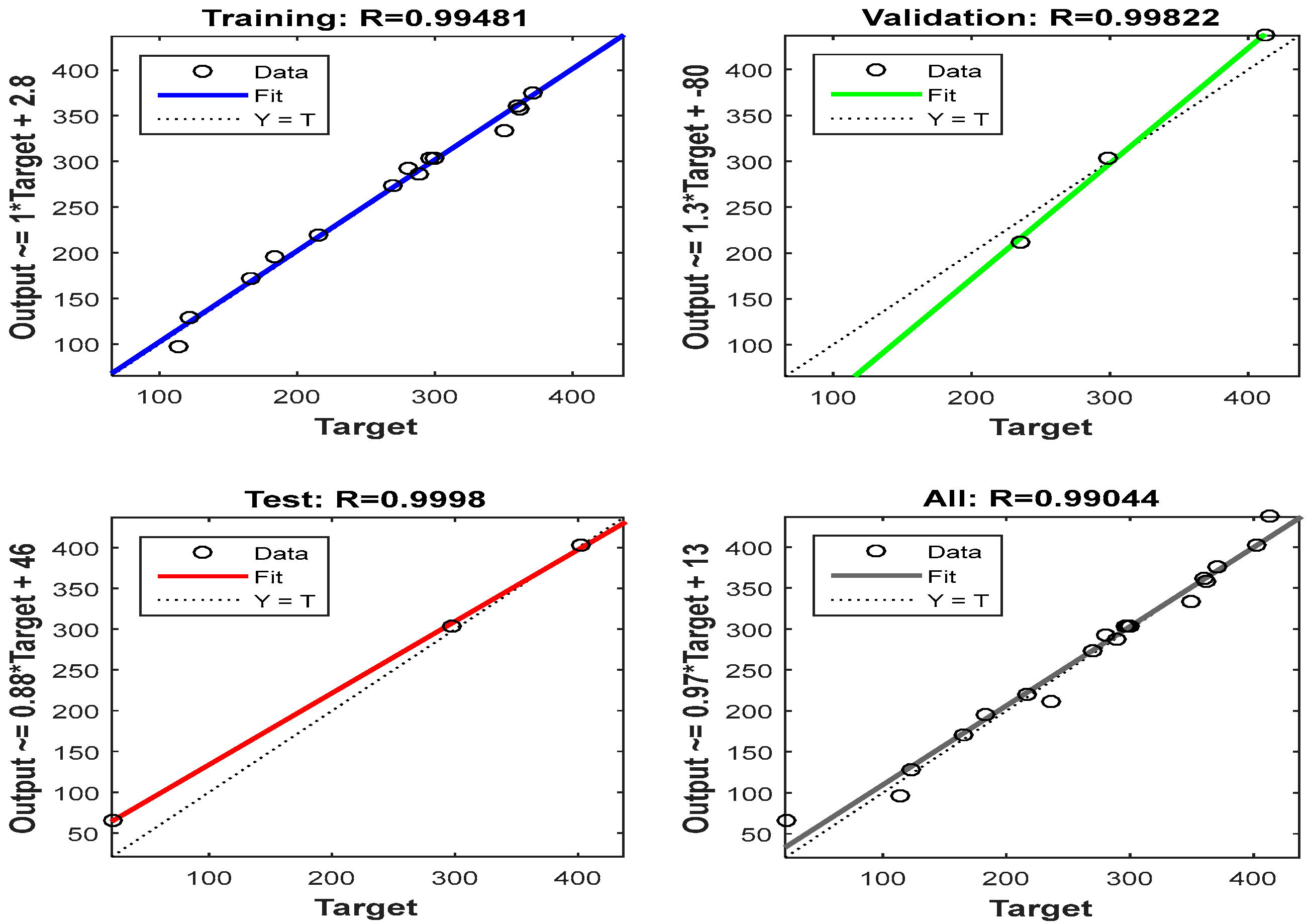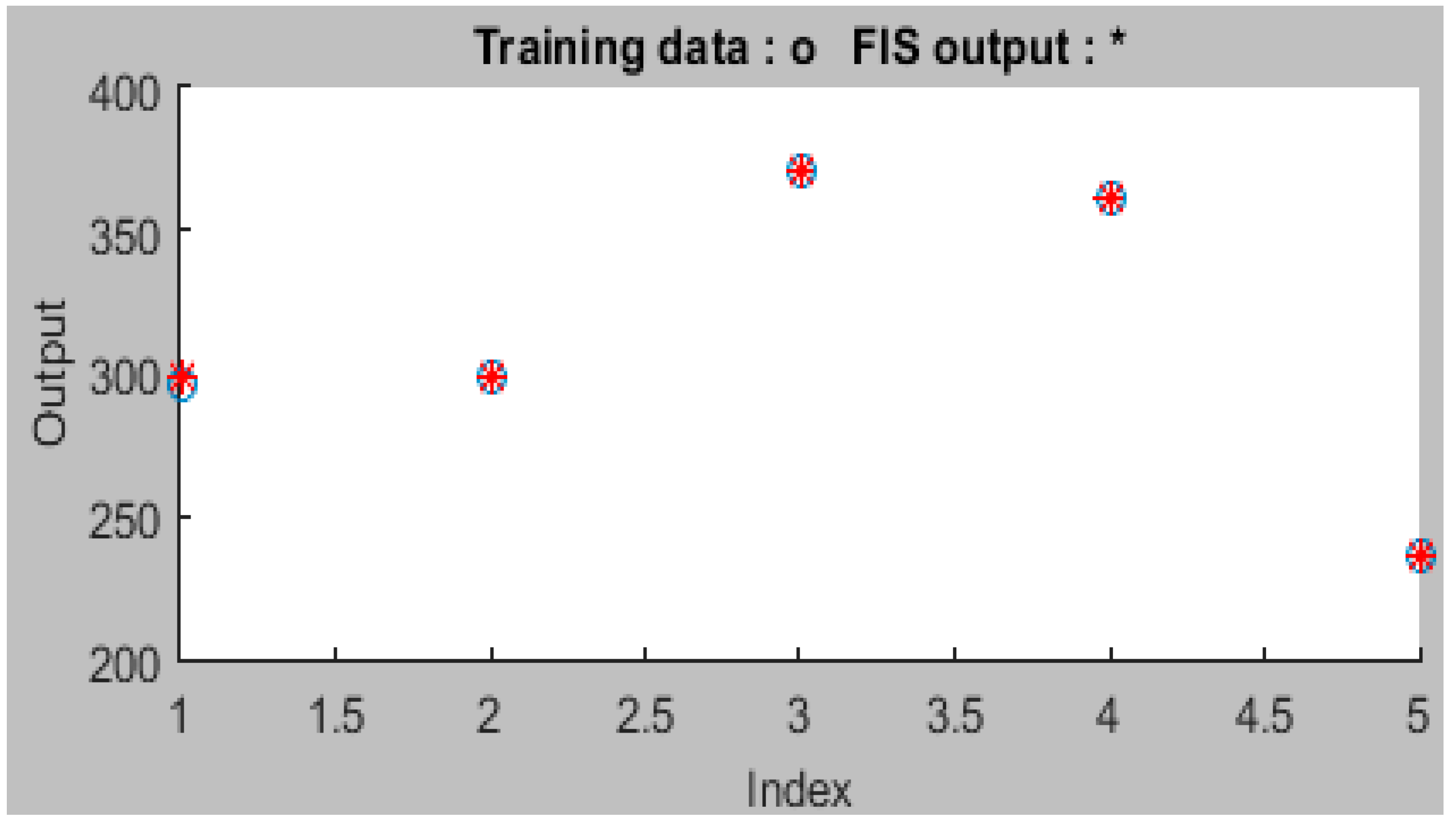Modelling and Optimisation of Zinc (II) Removal from Synthetic Acid Mine Drainage via Three-Dimensional Adsorbent Using a Machine Learning Approach †
Abstract
:1. Introduction
2. Materials and Methods
3. Results and Discussion
4. Conclusions
Author Contributions
Funding
Institutional Review Board Statement
Informed Consent Statement
Data Availability Statement
Acknowledgments
Conflicts of Interest
Abbreviation
| RMSE | Root mean square error |
| BP | Back propagation |
| LM | Levenberg–Marquardt model |
| CNCs | Cellulose nanocrystals |
| ANFIS | Adaptive neuro-fuzzy inference system |
References
- Azad, H.; Mohsennia, M.; Cheng, C.; Amini, A. Facile fabrication of PVB-PVA blend polymer nanocomposite for simultaneous removal of heavy metal ions from aqueous solutions: Kinetic, equilibrium, reusability and adsorption mechanism. J. Environ. Chem. Eng. 2021, 9, 106214. [Google Scholar] [CrossRef]
- Kabuba, J.; Banza, M. Results in Engineering Ion-exchange process for the removal of Ni (II) and Co (II) from wastewater using modified clinoptilolite: Modeling by response surface methodology and artificial neural network. Results Eng. 2020, 8, 100189. [Google Scholar] [CrossRef]
- Kabuba, J.; Banza, M. Modification of clinoptilolite with dialkylphosphinic acid for the selective removal of cobalt (II) and nickel (II) from hydrometallurgical effluent. Can. J. Chem. Eng. 2021, 99, S168–S178. [Google Scholar] [CrossRef]
- Olad, A.; Doustdar, F.; Gharekhani, H. Fabrication and characterization of a starch-based superabsorbent hydrogel composite reinforced with cellulose nanocrystals from potato peel waste. Colloids Surf. A Physicochem. Eng. Asp. 2020, 601, 124962. [Google Scholar] [CrossRef]
- Banza, M.; Rutto, H. Selective removal of Cr (VI) from hydrometallurgical effluent using modified cellulose nanocrystals (CNCs) with succinic anhydride and ethylenediaminetetraacetic acid: Isotherm, kinetics, and thermodynamic studies. Can. J. Chem. Eng. 2023, 101, 896–908. [Google Scholar] [CrossRef]
- Danial, W.H.; Majid, Z.A.; Muhid, M.N.M.; Triwahyono, S.; Bakar, M.B.; Ramli, Z. The reuse of wastepaper for the extraction of cellulose nanocrystals. Carbohydr. Polym. 2015, 118, 165–169. [Google Scholar] [CrossRef]
- Du, H.; Liu, W.; Zhang, M.; Si, C.; Zhang, X.; Li, B. Cellulose nanocrystals and cellulose nano fi brils based hydrogels for biomedical applications. Carbohydr. Polym. 2019, 209, 130–144. [Google Scholar] [CrossRef] [PubMed]
- Olatunji, O.M.; Horsfall, I.T.; Onuoha-Ukoha, E.; Osa-aria, K. Application of hybrid ANFIS-based non-linear regression modeling to predict the %oil yield from grape peels: Effect of process parameters and FIS generation techniques. Clean. Eng. Technol. 2022, 6, 100371. [Google Scholar] [CrossRef]
- Banza, M.; Rutto, H.; Seodigeng, T. Soil and Sediment Contamination: An International Application of Artificial Neural Network and Shrinking Core Model for Copper (II) and Lead (II) Leaching from Contaminated Soil Using Ethylenediaminetetraacetic Acid Application of Artificial Neural N. Soil Sediment Contam. Int. J. 2023, 1–21. [Google Scholar] [CrossRef]



| Input | Range | Output |
|---|---|---|
| 1. pH | 3–9 | Adsorption capacity (mg/g) |
| 2. Concentration Zn (II) | 50–300 | |
| 3. Time (min) | 20–180 | |
| 4. Dosage adsorbent (mg/L) | 2–10 |
| Error Function | RSM | ANN | ANFIS |
|---|---|---|---|
| MPSD | 0.015 | 0.006 | 0.004 |
| MSE | 0.011 | 0.006 | 0.002 |
| R2 | 0.985 | 0.990 | 0.997 |
Disclaimer/Publisher’s Note: The statements, opinions and data contained in all publications are solely those of the individual author(s) and contributor(s) and not of MDPI and/or the editor(s). MDPI and/or the editor(s) disclaim responsibility for any injury to people or property resulting from any ideas, methods, instructions or products referred to in the content. |
© 2023 by the authors. Licensee MDPI, Basel, Switzerland. This article is an open access article distributed under the terms and conditions of the Creative Commons Attribution (CC BY) license (https://creativecommons.org/licenses/by/4.0/).
Share and Cite
Banza, M.; Seodigeng, T. Modelling and Optimisation of Zinc (II) Removal from Synthetic Acid Mine Drainage via Three-Dimensional Adsorbent Using a Machine Learning Approach. Eng. Proc. 2023, 37, 52. https://doi.org/10.3390/ECP2023-14711
Banza M, Seodigeng T. Modelling and Optimisation of Zinc (II) Removal from Synthetic Acid Mine Drainage via Three-Dimensional Adsorbent Using a Machine Learning Approach. Engineering Proceedings. 2023; 37(1):52. https://doi.org/10.3390/ECP2023-14711
Chicago/Turabian StyleBanza, Musamba, and Tumisang Seodigeng. 2023. "Modelling and Optimisation of Zinc (II) Removal from Synthetic Acid Mine Drainage via Three-Dimensional Adsorbent Using a Machine Learning Approach" Engineering Proceedings 37, no. 1: 52. https://doi.org/10.3390/ECP2023-14711
APA StyleBanza, M., & Seodigeng, T. (2023). Modelling and Optimisation of Zinc (II) Removal from Synthetic Acid Mine Drainage via Three-Dimensional Adsorbent Using a Machine Learning Approach. Engineering Proceedings, 37(1), 52. https://doi.org/10.3390/ECP2023-14711





